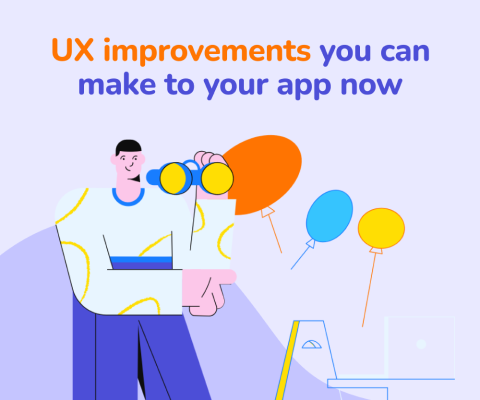December 17th, 2025, posted in for_founders
by Adelina
If you personalize an app right, you can greatly improve user experience. Think of it this way, you open a ride sharing app and it shows you an estimate how much it’ll cost to get a ride home. Before you even ask. It noticed you grab rides home at the same time of day and used that information to cater to your needs.
In this article, we’re going to discuss the importance of in-app personalization for transportation apps. Specifically, features such as tracking user behavior, suggesting personalized routes, creating custom notifications and more. We aim at showing it’s essential to get to know your users and adapt features to their needs, so they reach for your app & services more often. If you’re curious about how to optimize your app’s personalization and user experience, you can check out our free UI/UX assessment to see where improvements might benefit your users.
By paying attention to your users and the way they interact with your app, you can gain valuable insights and drive growth in your business by adding features they might not have even known they needed. This shows your users that you care about their experience.
In the case of transportation apps, it’s crucial to personalize your users’ experience: they use these apps as tools, to make their lives easier. Most times they’d open your app in a hurry to get somewhere, and as a product owner you can help them do that faster & easier.
A trend in food delivery apps, for instance, is giving suggestions based on previous user experience - recommending places they order from often or places with promotions active. This makes it seem like you listen to your users and you guide them into making choices faster, which in turn can make them use your app more often.
Gathering user data - and keep it private
A good way to scare off users of a ride-sharing app is telling them “you go to this bar often, here’s a special deal for you tonight”. When personalizing a transportation app, as much as you want to aid users, you shouldn't do it in a way that invades their privacy, or makes it seem like you track their movements in a stalker-y way.
Tracking customer data and ethics aren’t mutually exclusive. The biggest and most important step you can take is asking users directly about how you should use their data: aside from your regular privacy policy which should respect the laws of the region you operate in (GDPR if you’re in the EU, for instance), you could simply ask users if they agree with you tracking their user activity in order to give them better usage recommendations. If you’re planning to track a lot of data that can be considered private, it’s best you ask first.
When doing this, you can specifically ask users what kind of user data they’re okay with having tracked. Such as times of day when they usually book rides, specific days of the week or frequent locations. You can eventually ask them to set up their home and work addresses - during onboarding - so you can quickly recommend them rides to said places - or you can let them opt out of everything. Letting them choose is a big part of this process.
Once users let you track their data, there are 2 big things you need to consider:
- How you’re going to use it
- How you’re going to safeguard it
When you get started, make a detailed plan of what kind of features you want to offer - this will help you determine what data to gather in the first place. Let’s say you want to offer pre-filled rides that customers can book faster: this means finding out where they go the most often. Even better if they go to the same places at similar times within a week, such as going home after work. This way you can turn user behavior into timed special offers and sell more rides. And, of course, you get to help customers get where they need, when they need to.
And of course, when you start gathering user data, it’s essential to keep it all in a secure server. Make sure only team members have access to sensitive information and that they use secure passwords. We shouldn’t have to tell you this, but obviously don’t sell or give away user data. Make sure you communicate to your customers that their data is kept safe and private.
Show users you know what they need
Just how Spotify recommends playlists you listen to often, ride-sharing apps can recommend places you go to often. You can start small by recommending recent destinations to your users - they’re likely to book them again - and later, destinations your users go to the most often.
Similarly, if they book rides often at the same time of day, you can program push notifications that say things such as “Getting off work? Grab a ride home for 10% off”. This makes it look like you care about your users and you’re making their lives easier. Now, of course, make sure the wording on those notifications makes it clear you’re just helping them out and not stalking their behavior. Don’t send out notifications that say “Out again at 4AM? Click here to quickly order a ride home”. For obvious reasons.
A lot of people in 2024 use ride-sharing apps to get to major transportation hubs that are normally hard to reach or they’d go there with luggage they don’t want to carry around. Once you get to know your target users and find out specific needs such as this, and then notice specific users often booking rides to airports or train stations, you can get ahead of the curve and suggest rides to these locations, featuring estimated prices, right when users open your app. This will make them feel like you’ve read their mind, when really all you did was notice patterns in their user behavior.
By doing this, users will notice your app is smart and uses their past ride data to their advantage. And they’ll reach for it more often when in a hurry, since you’re offering them useful shortcuts. Given that we’re talking about a mobile app, of course. Offering special deals or promotions for these types of rides can also increase conversions. Who wouldn’t like a good deal, right? This is especially helpful if your app is competing with a lot of similar ride-sharing apps. What you need here is customer loyalty, after all.
When it comes to ride-booking times, this, of course, depends on the habits of all your users. Some might leave for their hometown every Friday at 2PM, which makes it very easy for you to cater to their needs and send out offers through push notifications in your mobile app. While others might book rides only when there’s no available public transport means late at night, for instance. The key here is gathering data, observing habits and offering ride suggestions at useful time intervals. Just how a food delivery app would notify you of limited offers at lunch time.
Grow your business by putting your users first
Gathering user data to turn it into useful features can not only make your customers happy, but it’ll also help grow your business. Since there’s no guesswork involved and you’re going off of hard data, you have great reasons to add essential features to your app - you know people will be using them because you’re giving them what they need.
This is not only helpful when it comes to adding features, but also when removing them. Tracking user habits can help you see what features of your app never get used, or which might have issues. Improving these can help your business in the long run. Additionally, you can also ask users for direct feedback and find potential hidden issues.
Personalizing apps means getting into the minds of your users, listening to their needs and catering the app to them. It improves their customer experience. This means growing your app into an essential part of their lives, which, in turn, can help grow your product and make you stand out among your competitors.
A big part of this is being clear & sure about who your audience is. Saying it’s “everyone” is very unhelpful - you can’t possibly create a personalized app experience for any kind of person. Picking office workers, for instance, who might book rides to and from the office around 9AM and 5PM, helps you add very specific features that make their lives easier - and which will make them use your app more.
Implementing personalization: from concept to execution
Now here’s an important bit - how do you even do all of this? It all sounds great, but how do you even get started? Here’s a possible strategy you could adopt when adding in-app personalization to a transportation app:
- Set a few goals right from the start: Clearly define why you want to implement in-app personalization. Understand what aspects of the user experience you want to personalize, such as trip recommendations, preferred routes, vehicle preferences, etc.
- Collect user data: Gather relevant data about users' preferences, behaviors, and demographics. Either past trip history, preferred pick up/drop-off locations, time of day preferences, payment methods, and more.
- Analyze the data you gathered: Use data analytics tools (such as Tableau, Qlik or even Excel) to analyze user data and identify patterns and trends. Do users book more rides at night time? Do they avoid rush hour? Understand user preferences, habits, and behaviors to tailor their experience.
- Split users into specific segments: Create user segments based on their characteristics and preferences. You’ll be able to see what kind of users you have and how they interact with your app. This segmentation can be based on factors like frequency of app usage, trip history, location, demographics, etc.
- Develop personalization algorithms: Develop algorithms that leverage user data and segmentation to personalize the user experience. For instance, recommendation engines, route optimization algorithms, dynamic pricing models, and limited offers. Integrate these new features gradually, so as to not shock your customers with too many new things.
- Implement Personalization Features: recommend trips based on their past trip history, location, and time preferences, let them quickly re-book locations they go to often, give a variety of options for their ride - whether more or less luxurious, give them good deals and promotions, notify them of traffic issues, and put clear UI emphasis on parts of the app you personalize.
- Test and iterate: Conduct extensive testing to ensure that personalization features work as intended - are your customers even using them? Are they using them right? Gather feedback from users and iterate on the features based on their suggestions and preferences.
- Keep private data private: Implement robust security measures to protect users' personal data and privacy. Make sure your app doesn’t violate GDPR or CCPA.
A big challenge with this is that it’ll take time to gather and analyze user behavior. You can’t get to know someone in just a few days, let alone thousands of users on an app. Use their recent activity to create recommendations and push more generic types of personalization until you gather enough data.
Another issue, which we mentioned earlier, is making sure the way you personalize your transportation app isn’t privacy-invading. You’re not stalking your users, but listening to their habits and making informed suggestions. Privacy is an important principle in 2024. Make sure they know that through clear notices / info pages. Give them easy access to your customer service in case they want to opt out, or the features don’t work in their favor.
A big part of implementing in-app personalization features is user research and creating good user flows, a job for UI/UX designers. You don’t have to go in blind, do it all yourself or let a robot do it for you. Hiring a good team can help you find what works best for your app & its users, and they can also implement that.
Are you trying to figure out if your app is personalized enough, or you’d like to find out if you’re doing a good job on the UX side? We offer a free UI/UX assessment worth $3K for free. Book a meeting with us and let’s help build up your app & business.


















